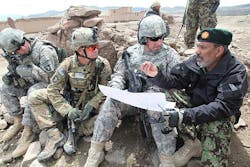Army scientists ask industry for camouflage fabrics that hide soldiers from electro-optical sensors
Officials of the U.S. Army Natick Soldier, Research, Development, and Engineering Center (NSRDEC) in Natick, Mass., released a request for technical papers Wednesday for the Short Wave Infrared Signature Reducing Technology project.
As the modern battlefield becomes ever-more technologically sophisticated, military researchers are searching for ways to help infantry and Special Forces warfighters on the ground avoid potentially hostile surveillance that involves electro-optical sensors.
Army researchers are beginning the process of developing and applying SWIR signature-reducing technologies to several kinds of fabrics while maintaining acceptable visible-light and near-infrared signatures.
Army experts primarily are interested in SWIR camouflage for Flame Resistant Defender-M (FR-DEFM); Flame Resistant ResQ2 (FR-ResQ2); 100 percent Nylon 500D (Ny500D); 100 percent Nylon 1000D (Ny1000D); and other military fabrics.
The camouflage patterns of interest are Operational Camouflage Pattern (OCP); Marine Corps Desert (MARPAT D); Marine Corps Woodland (MARPAT W); and Marine Corps Coyote solid (MC Coyote).
This SWIR camouflage project is part of the Army's overall research into warfighter counter-surveillance technologies outlined in broad agency announcement W911QY-15-R-0016, which is online at http://www3.natick.army.mil/NSRDEC-Broad-Agency-Announcement.aspx.
Army researchers will evaluate candidate SWIR camouflaged fabrics for comfort, durability, colorfastness and signature properties. Initial SWIR target reflectance values should have at least three levels of reflectance with evident separation among them.
The highest SWIR reflectance level should be about 65 percent, while a mid-range level should be about 45 percent, and a low-range level at about 25 percent. Vendors should propose to print on one or more of fabric substrates of interest.
Related: Laser-pitting technology may yield more opportunities for advanced camouflage
Companies responding should describe suggested technologies and identify how their technology offers camouflage protection. Information should include technical test data; test methodology; certification; status and specifications for manufacturing and production; any unique or proprietary construction requirements; and any other information that demonstrates the value of technologies.
Mail responses to be received no later than 15 April 2015 to the Army's James Fairneny or Anabela Dugas, Fiber and Textile Science Team, ATTN: RDNS-SEW-TMF, 15 Kansas St., Natick, MA 01760-5019.
Email questions or concerns to the Army's James Fairneny at [email protected], or Anabela Dugas at [email protected].
More information is online at https://www.fbo.gov/notices/556510a7f7d6648e0548267c95cf70a0.
